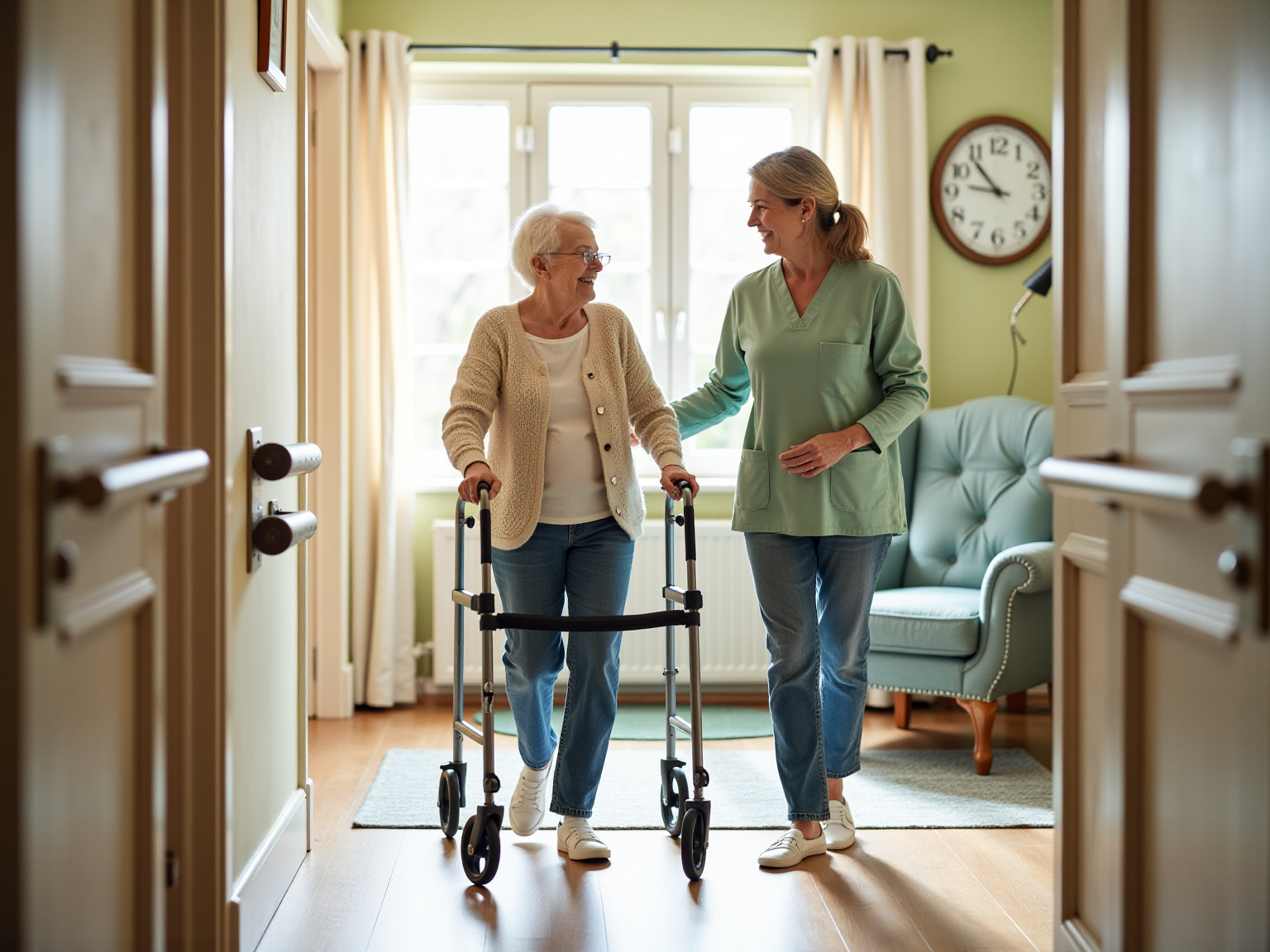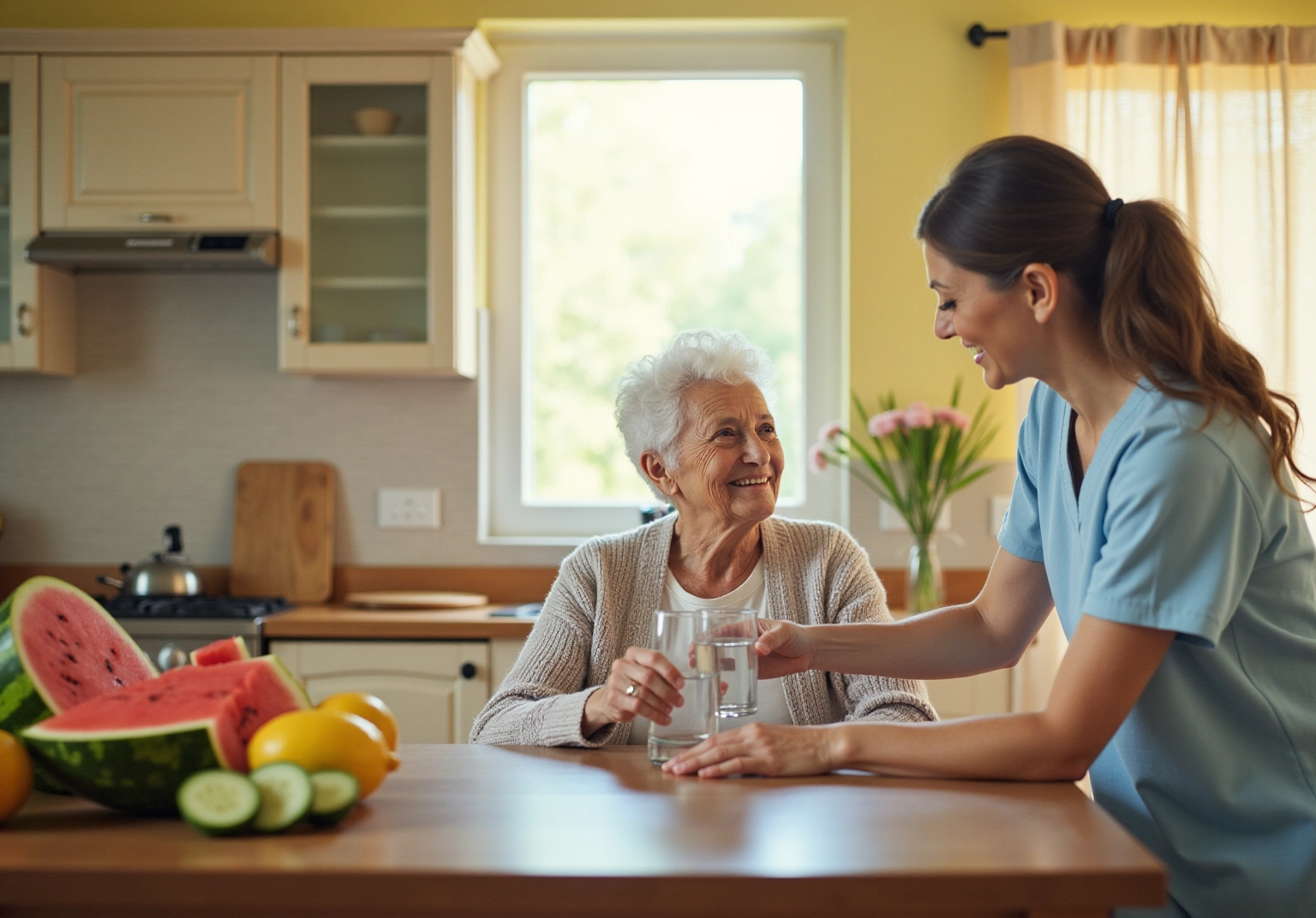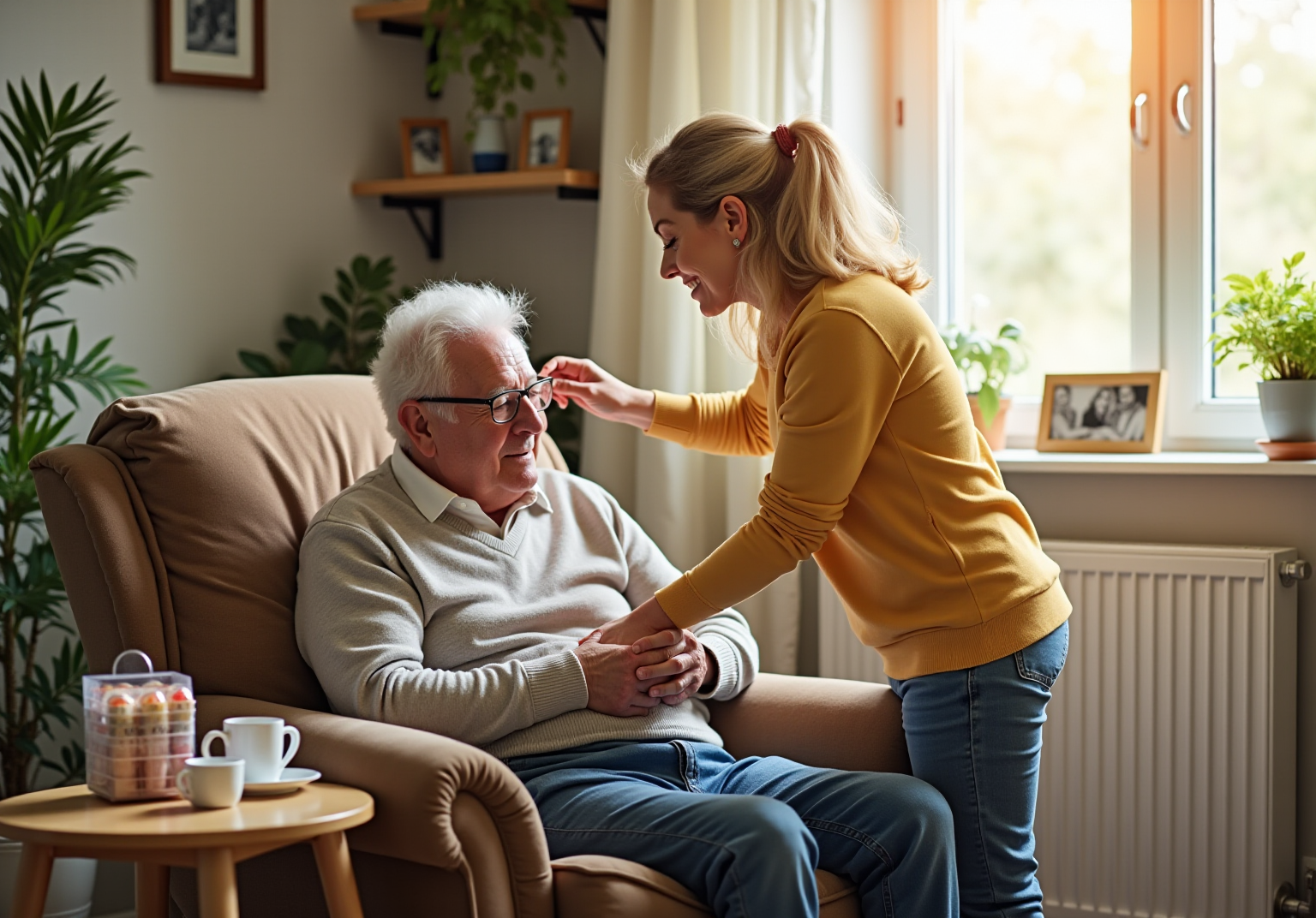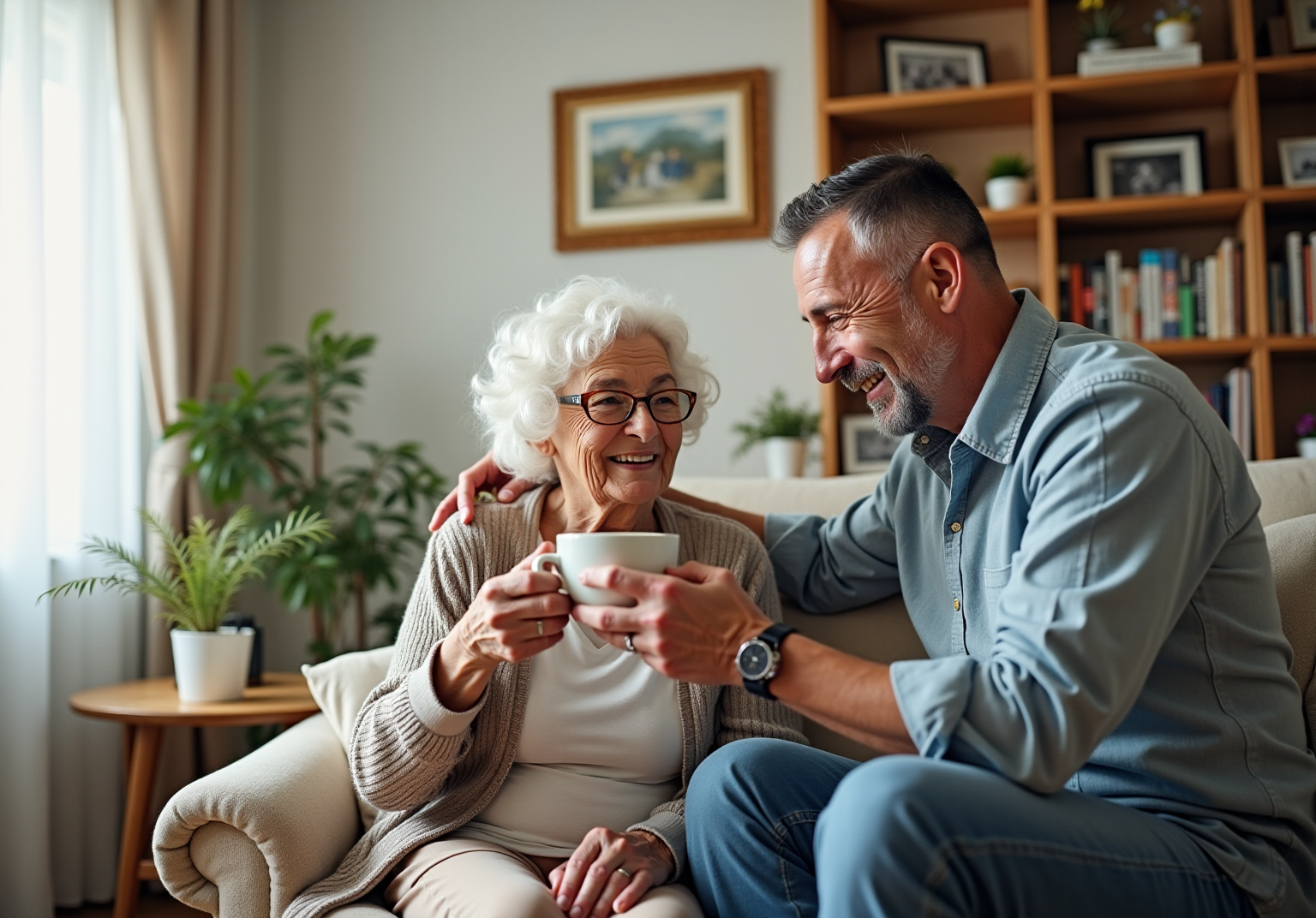Overview
The essential steps for in-home assistance for seniors begin with a heartfelt assessment of home safety and accessibility. It’s crucial to assemble a compassionate caregiving team that understands the unique needs of each individual. Establishing clear communication and care plans is vital in this journey.
Practical measures for enhancing safety are outlined, ensuring that every corner of the home is conducive to well-being. We emphasize the importance of a supportive caregiving network, as it can significantly uplift the spirits of seniors. Furthermore, clear communication and adaptable care strategies are essential to ensure that seniors feel secure and valued in their home environment.
Remember, your comfort is our priority, and we’re here for you every step of the way. By taking these steps, we can create a nurturing atmosphere that allows seniors to thrive at home.
Introduction
Creating a safe and supportive home environment for seniors is not just important; it’s a heartfelt commitment that can greatly enhance their quality of life. As families navigate the complexities of caregiving, it’s essential to recognize the steps needed to ensure safety and accessibility. Have you considered how a thorough home assessment could make a difference? By assembling a dedicated caregiving team, every action taken can significantly contribute to the well-being of your elderly loved ones.
This article explores practical strategies for improving home safety, establishing effective communication, and crafting personalized care plans that cater to individual needs. Together, we can foster independence and happiness during these golden years. Remember, your comfort and peace of mind are our priorities, and we’re here for you every step of the way.
Assess Home Safety and Accessibility
Conducting a comprehensive home safety assessment is essential to identify hazards such as loose rugs, inadequate lighting, and cluttered walkways that could lead to accidents. By collaborating with Best Care Nurses Registry, you can ensure that qualified support staff are referred for in-home assistance for seniors. This not only helps implement these safety measures but also offers emotional comfort for family members concerned about their loved ones’ well-being. Our caregivers are carefully screened and committed to excellence, providing in-home assistance for seniors to ensure that your loved one enjoys healthy, meaningful days at home.
Consider the following safety measures:
- Install grab bars in bathrooms and handrails on staircases to provide essential support and reduce the risk of falls.
- Ensure all areas of the home are well-lit, particularly stairways and hallways, to enhance visibility and safety.
- Remove or secure any loose cords or wires that could pose tripping hazards to create a safer environment.
- Install non-slip mats in bathrooms and kitchens to prevent slips, which are common in these areas.
- Evaluate the accessibility of entryways; installing ramps or stairlifts may be necessary to facilitate safe access.
- Regularly check smoke detectors and carbon monoxide alarms to ensure they are functioning properly, as these devices play a key role in safety.
Remember, it costs less to be safe every day than to make one careless mistake along the way. Implementing these modifications can significantly reduce the risk of falls among older adults, especially with in-home assistance for seniors. Studies indicate that proper safety measures can lower the risk of injury. As Sir Brian Appleton stated, “Safety is not an intellectual exercise to keep us in work. It is a matter of our contributions to safety management that determines whether the people we work with live or die.” By prioritizing safety, families can create a secure living environment that supports the independence and well-being of their loved ones through in-home assistance for seniors.
Moreover, be aware that about 93% of all crime experienced by adults 65 and older is property crime, highlighting the necessity of protective measures in the home. With Best Care Nurses Registry in your corner, you can ensure that your loved one is not only safe but also happy and well-cared for. We’re here for you—call now to discuss your needs and explore the personalized service plans we provide.
Assemble Your Caregiving Team
- Begin by recognizing the unique needs of the elder, which may include personal assistance, medical support, or companionship. Understanding these needs is vital for identifying the appropriate type of assistance required. At Best Care Nurses Registry, we offer personalized planning to ensure that each elder receives tailored support that enhances their quality of life and independence.
- Involve family members and friends in the support process. Their engagement can range from providing direct assistance to offering emotional support, both of which are essential for the elder’s well-being. As Taylor Shuman notes, 50 percent of family caregivers have had to adjust their work schedules to accommodate their responsibilities, highlighting the importance of teamwork.
- When hiring professional caregivers or nurses, ensure they are thoroughly screened and trained in elder care. At Best Care Nurses Registry, our CNAs and HHAs are dedicated to delivering compassionate support with daily living activities, such as bathing, dressing, meal preparation, and medication reminders, ensuring a high standard of service and the safety of your loved one.
- Clearly define the roles and responsibilities of each member of the caregiving team. This clarity helps prevent overlap and confusion, ensuring that all aspects of support are addressed effectively. Our supporters play a crucial role in keeping family members and decision-makers informed about the elder’s condition, fostering a collaborative environment.
- Schedule regular meetings to evaluate the elder’s progress and make necessary adjustments to the support plan. Consistent communication among team members enhances service quality and allows for timely updates to the personalized care plan.
- Leverage technology, such as shared calendars or communication apps, to keep everyone informed and aligned. This can streamline scheduling and updates, ensuring all caregivers are in sync with the elder’s needs.
- Experts suggest that the typical number of caregivers per senior in home assistance is often underestimated, which underscores the financial implications of providing care. As the aging population grows, proactive strategies for building support teams will become increasingly important. Additionally, it is essential to recognize the dynamics of caregiving relationships, as they can sometimes become strained, necessitating careful selection and oversight of caregivers.
- To learn more about how Best Care Nurses Registry can assist you in creating a personalized support plan that meets your needs, call us today at (888) 203-2529.
Establish Communication and Care Plans
Create a thorough care plan that includes the individual’s medical history, daily routines, and specific care requirements. This essential document serves as a guide for those providing care, ensuring that all facets of the elder’s health and lifestyle are considered. To evaluate if an elderly relative needs CNA/HHA assistance, assess their capacity to carry out daily tasks and overall health condition. Indicators such as difficulty with personal hygiene, dressing, cooking, cleaning, or managing medications are crucial. Health issues, including persistent ailments or recent operations that require continuous attention, should also be assessed.
Establish quantifiable health objectives customized to the senior’s needs, such as enhancing mobility, managing medications, or improving overall well-being. These objectives provide clear targets for caregivers and assist in monitoring progress over time. According to a study, the effectiveness of support plans can be evaluated with a Cronbach’s alpha of 0.84, indicating strong reliability in measuring communication confidence among providers.
In addition, establish a robust communication protocol among providers, specifying preferred methods of contact—whether through phone calls, texts, or in-person meetings. Effective communication is crucial for coordinating care and addressing any concerns promptly. As noted by the Wisconsin Community Advisors on Research Design and Strategy (CARDS) team, the understandability of communication is vital for effective caregiving. Consistently communicate with your loved one to discuss their experiences and any worries, and ask for regular updates from the support person to ensure quality care.
Furthermore, cultivate an atmosphere of open conversation with the elder, motivating them to share their preferences and concerns. This involvement not only strengthens the elder but also ensures that their input is essential to the support plan. Personal insights from caregivers emphasize the emotional ups and downs of providing support, highlighting the significance of self-care and communication in addressing these obstacles.
As a result, consistently review and revise the support plan to reflect the senior’s changing needs and include input from the caregiving team. This adaptability is essential for maintaining effective support as circumstances change. The study concluded that while communication confidence improved, further investigation is needed to assess long-term benefits, underscoring the necessity for continuous enhancement in management strategies.
Document all support activities and observations meticulously. Maintaining a clear record of the senior’s progress and any issues that arise is essential for ongoing evaluation and modification of the support plan.
Moreover, it is crucial to understand the roles of CNAs and HHAs. CNAs (Certified Nursing Assistants) are trained to perform medical tasks such as taking vital signs and administering medications, while HHAs (Home Health Aides) focus on personal assistance and daily living activities. To connect with empathetic support providers, follow these steps:
- Call to speak with our friendly staff to discuss your needs.
- Discuss your situation and seek a care plan from your doctor.
- Choose from the referred caregivers who best fit your requirements.
Conclusion
Creating a safe and supportive home environment for seniors is essential for their well-being. Conducting a thorough home safety assessment helps identify hazards and implement necessary modifications, such as:
- Installing grab bars
- Improving lighting
These changes significantly reduce the risk of falls, allowing seniors to maintain their independence while providing peace of mind to their families.
Assembling a dedicated caregiving team is equally important. Involving family members and professional caregivers fosters collaboration to meet each senior’s unique needs. Clear communication and defined roles enhance care quality, while regular updates ensure the team adapts to evolving circumstances.
Establishing a comprehensive care plan acts as a roadmap for caregivers, setting measurable health goals and facilitating effective communication. Documenting care activities and reviewing the plan regularly allows families to stay responsive to their loved ones’ needs.
In summary, our commitment to enhancing seniors’ quality of life through safety and personalized care is profound. By prioritizing these strategies, families can create an environment that safeguards their loved ones and fosters happiness and independence. This collective effort ensures that seniors enjoy their golden years with dignity and joy, surrounded by the care they deserve. Remember, we’re here for you, and your comfort is our priority.
Frequently Asked Questions
Why is conducting a home safety assessment important?
Conducting a home safety assessment is essential to identify hazards such as loose rugs, inadequate lighting, and cluttered walkways that could lead to accidents.
How can Best Care Nurses Registry assist with home safety for seniors?
Best Care Nurses Registry can refer qualified support staff for in-home assistance, helping to implement safety measures and providing emotional comfort for family members concerned about their loved ones’ well-being.
What are some recommended safety measures to implement in the home?
Recommended safety measures include installing grab bars and handrails, ensuring adequate lighting, securing loose cords, using non-slip mats, evaluating entryway accessibility, and regularly checking smoke detectors and carbon monoxide alarms.
How can these safety modifications impact older adults?
Implementing these modifications can significantly reduce the risk of falls among older adults and lower the risk of injury, promoting a safer living environment.
What is the significance of property crime for seniors?
About 93% of all crime experienced by adults 65 and older is property crime, highlighting the necessity of protective measures in the home.
How does Best Care Nurses Registry ensure quality in-home assistance?
Best Care Nurses Registry carefully screens caregivers who are committed to excellence, providing in-home assistance for seniors to ensure their safety and well-being.











